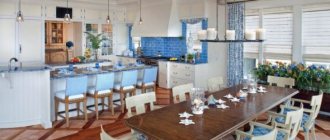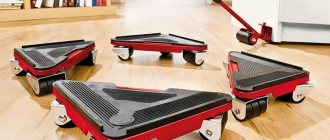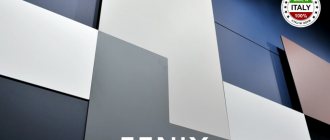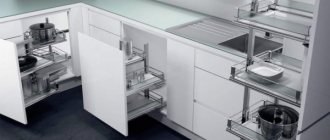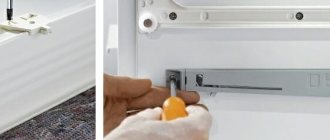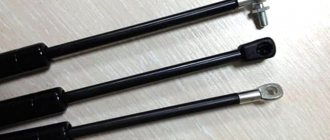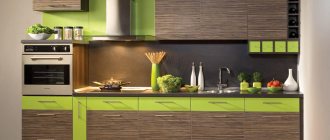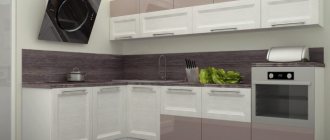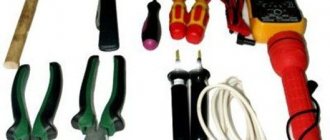Fittings are the general name for a whole set of auxiliary elements and structural components that ensure the correct functionality of any headset. In this particular case, we mean handles, guides for drawer cabinets, holders for legs and other similar products. The peculiarities of their creation and technical characteristics are of no small importance for the correct operation of the headset and its service life. And what to pay attention to, how to choose high-quality fittings, and which company’s offers are considered the best at the moment, we will consider in the review below.
Description of auxiliary elements
Modern fashion requires a completely smooth surface or a minimum of details. However, this approach does not in any way detract from the performance and aesthetics of the kitchen set. Thanks to these requirements for fittings, push systems have become popular, opening the doors with a light touch, which also includes dampers and closers for cabinets. Classic design options, which, by the way, come with standard hinges, are also not left out. By 2022, the following parts will be identified to help manipulate doors and drawers.
Assembly components:
- all kinds of lifting mechanisms and dumbwaiters;
- connecting guides and retractable systems.
Fasteners are a whole complex of devices responsible for fixing furniture parts, including those with the walls of the room. These include:
- locks;
- loops;
- screeds;
- screws;
- supports;
- and shelf holders.
Facial details. Everything seems to be clear here, they include:
- pens;
- special latches;
- decorative elements.
Most external parts often serve as accompanying accessories. Like, for example, the work area along the apron itself. Where another element of the kitchen set found its place - open wall shelves.
The fasteners for them are:
- beech dowels or plastic dowels;
- brackets;
- standard sets of screws;
- screws;
- loops.
They are found in almost every home and are indispensable for various small items, bulk products and small equipment. Decorative loads are also provided by sets of steel or plastic hooks and devices for various small parts, such as a holder for drying towels. Such structures are mounted above the stove itself, giving the kitchen complex a generally harmonious appearance.
Repulsion systems
Is it possible to open a cabinet without handles? Can. To do this, you can use the repulsion system. Externally, it is very similar to a shock absorber and even performs its functions. But the main feature of this system is that when you press the door, the pusher moves the door to a distance of up to 6 cm, which allows you to open it further by hand without using the handles. In this way, you can make a facade without handles, and at the same time save a lot of money on the latter.
Fig.35.
The cabinet doors do not need to be equipped with handles, but pushers can be installed. When you press the door, the mechanism will push the door away by about 5-6 cm, in which case it will be convenient to open it by hand. This way you can make a very interesting facade without handles.
Repellers come in mortise and overhead types. They are installed similarly to shock absorbers. The difference in installation is that they must be mounted on the wall opposite to where the hinges are installed. To hold the door, pushers can be equipped with magnets. The repeller operation is adjusted by rotating the rod, so you can select the optimal repulsion value.
Repulsion systems can be used for both doors and drawers, together with any other mechanisms, from hinges to elevators.
Criterias of choice
Following these recommendations will help you avoid mistakes when replacing kitchen fittings.
- To begin with, you need to set your priorities correctly, since each subgroup has certain requirements, for example; when choosing external parts, it is better to focus on their presentability, and in the case of fasteners, it is preferable to pay attention to quality and functionality.
- The auxiliary parts are expected to be instantly replaceable; each such part must be very durable and fit tightly into the corresponding grooves.
- Quality of the material. Kitchen components usually consist of metal, plastic, and less often glass or wood. Particular attention should be paid to the selection of fastening and component systems - it is better not to save money here. Budget options are prone to rapid wear and tear and regular replacement, which will cost much more.
- The popularity of the manufacturer, as a rule, high-quality products win the respect of consumers.
- Even the best elements must correspond to the overall chosen style, without being conspicuous and creating a neat appearance for the set.
- Chrome elements are suitable for a high-tech kitchen.
- The classics will be emphasized by gilding or bronze.
- In modern style, painted details are welcome.
- Mediterranean style requires natural elements.
Advice to avoid mistakes when choosing, before ordering kitchen components online, you should clarify the parameters in accordance with the already existing parts. Or even take a photo of the old item and use the help of a sales consultant, which is certainly available in every online store.
Hinges: types, installation methods
There are as many structural varieties of hinges as there are varieties of furniture handles. However, unlike the latter, for each type of loop there are special formulas (tables) for calculating installation dimensions. When calculating hinges, the type of hinge, method of fastening, thickness of the facade, reveal (the gap between adjacent doors) and several other parameters are taken into account. All calculations are simple, but they are needed mainly for the industrial production of furniture. To make furniture with your own hands, it is important to choose the right type of hinge, know the adjustment methods, and the connecting dimensions can be left to the organization that will manufacture the furniture parts.
As already mentioned, there are many types of designs, but the most common is the mortise four-hinged hinge. It and its design options will be discussed further. A four-hinged hinge consists of the hinge itself and the mounting bar. The hinge is attached to the front, the strip to the wall of the drawer. Both parts are connected using the screws included with the hinge.
According to the method of application, hinges can be divided into overhead, inset and for corner drawers. An overhead hinge is designed for a door that, when closed, “overlaps” the end of the drawer. The inset hinge is designed for a door that, when closed, is flush with the end of the drawer. There are also semi-overlay hinges, which are convenient to use for adjacent doors, but then it is necessary to carry out additional calculations of the installation dimensions of the hinges and the dimensions of the facade panels in order to maintain the gap between the doors.
Fig.20.
Depending on the method of installation of the facade, various hinges are used. If the door is recessed into the body of the cabinet, then an inset hinge is used; if the door is placed on the end of the cabinet, then an overhead hinge is used.
Corner hinges are designed for doors that are located at an angle to the side walls of the drawer. There is also a version of hinges that are designed to attach the door to the wall of the box at an angle of 180 degrees (attachment to the false panel).
Fig.21.
Hinges are angled 30, 45 degrees and for false panels 180 degrees. It is important to note that corner hinges come with opening angles of +30, 45 (obtuse angle) and -30, 45 (acute angle), depending on whether the cabinet has an acute or obtuse angle where the door is installed.
Another important hinge parameter is the door opening angle. Depending on which hinge is installed, the cabinet door can open at an angle of 90, 110, 120 degrees. Using hinges with a door opening angle of more than 90 degrees can be very convenient for hard-to-reach or deep cabinets.
An important point in choosing hinges is determining the number of hinges per door. Since the hinge has a certain maximum permissible load, depending on the size and weight of the door, from 2 to 5 hinges may be required. The following recommendations on the number of hinges are given based on the fact that the door material is a 16 mm thick chipboard panel, the panel width is 60 cm. So for a panel up to 90 cm high (weight 4-8 kg) you need 2 hinges, from 90 to 160 cm (8 -13 kg) – 3 loops, up to 160 to 200 cm (13-17 kg) – 4 loops. The maximum dimensions are given; to ensure reserve, 1 loop can be added to each size group.
Fastening furniture hinges to the facade and drawer is carried out in the following way. A groove is made in the façade panel for the bowl using a router or Forstner drill. Next, the loop is secured to the facade panel with self-tapping screws. On the side of the cabinet, a place is marked for the installation platform, after which it is secured with self-tapping screws.
Fig.22.
Fig.23.
Fig.24.
Fig.25.
It is possible to do as described above only by knowing all the installation dimensions. You can determine them using special tables in the instructions for the loop. In practice, at home, it is convenient to do things a little differently. It is important that the quality of the hinge installation does not suffer from this.
Typically, the outer hinges are located at a distance of 10 - 15 cm from the top and bottom of the door, the intermediate ones are evenly distributed in the space between the outer hinges. To ensure a gap between adjacent doors, for most hinges a distance of 4-5 mm is made from the end (side) of the door (the exact size is indicated in the instructions for the hinge). Based on these dimensions, a groove with a diameter of 35 mm (the most common size of a hinge bowl) and a depth of 12.5 mm is milled into the facade panel.
Next, the loop and the platform are connected, all adjusting screws are brought to their extreme position. Then the loop is fixed to the facade, while making sure that the loop is located at a right angle to the facade. Then, holding the door in the desired position, secure the mounting bar to the drawer. In order for the door to hold, it is enough to install 1 self-tapping screw in the mounting strips of the outer hinges. Now you can adjust the door height and secure it with the remaining screws.
Fig.26.
The height of the doors is adjusted using the fasteners of the installation strip. To make adjustments, loosen the screws and install the door in the desired position. Then tighten the fasteners.
The final stage is adjusting the position of the facade. The door has already been adjusted in height using the self-tapping screws that secure the bar at the previous stage. Now you need to adjust it for reach and inclination. Two adjusting screws No. 2 and No. 3 are responsible for this.
By releasing screw No. 2, the door can move back and forth. In order for the door to stand level and not touch the drawer when opening, you need to move the door 2-3 mm towards you. A similar operation must be repeated with all loops.
Fig.27.
Using screw 2, the gap between the door and the furniture body is adjusted. A sufficient gap of 2-4 mm. Screw 3 is responsible for the tilt of the door and the gap between adjacent doors.
Screw No. 3 is responsible for adjusting the door tilt; at the same time, using this screw, the gap between adjacent doors is adjusted. By rotating screw No. 3, it is necessary to achieve a uniform gap between the doors and eliminate possible tilt of the doors in the horizontal plane. This adjustment is performed first with the outer loops. The intermediate ones are adjusted to fit the already exposed door.
Often, when building a kitchen set, it is difficult to install doors in a corner cabinet of an L-shaped kitchen, in particular which hinges to choose for such a cabinet. It's actually quite simple. The door of such a cabinet consists of 2 parts. The composite door is attached to the kitchen unit using a regular hinge, but with an opening angle of 120 degrees. The door halves are fastened together with hinges for a false panel with an opening angle of 90 degrees.
Fig.28.
Fig.29.
Fig.30.
Fig.31.
The best manufacturers of budget components
TBM
The company from the Northern capital has long been on the lips of consumers; the company has its own production. Their assortment includes various panels, windows, as well as high-quality, mainly metal, fittings.
Video about TBM furniture handles:
Another bright representative of the German industry with many years of experience. The main directions of the company were:
- applied and mortise handles;
- fastenings with plug-in elements;
- options in the form of staples and with a plastic base;
- as well as blinds for kitchen fittings;
- waste sorting systems, including built-in waste compartments.
The Fennel brand actively uses the latest innovative developments in this area. Combining in its offer comfortable ergonomics and freshness of execution together with real German quality. Fennel GmbH&Co., cg components are popular among kitchen furniture manufacturers, repairmen and simply zealous homeowners.
FENNEL handles
Advantages:
- Quality of materials;
- reliability;
- long period of operation;
- price+quality combinations.
Flaws:
- Not everywhere.
Cost: from 295 ₽
AMIG
According to buyers, this company is not inferior in quality to the leaders in the furniture fittings market. The main advantage of their products is the interchangeability of products, that is, if one part breaks, there is no need to completely replace the entire mechanism. In addition, the elements released by the brand are designed in an antique style, making them an excellent accessory for a classic interior or one made from natural materials.
furniture fittings AMIG
Advantages:
- A wide range of;
- interesting design;
- high quality;
- reliability of fastening;
- manufacturing basis;
- you can choose the desired color;
- retains its appearance for a long time.
Flaws:
- A specific design does not fit everywhere.
Cost: from 300 ₽
Which fastening hardware to choose for certain types of material
Modern manufacturers make furniture not only from chipboard, but also from other materials.
Thanks to the wide range of fittings, you can choose fasteners for any type of furniture
Table 6. Selection of fasteners based on the furniture material.
| Material | Description |
| Glass | Fasteners such as self-tapping screws (of the “quick installation” type) are used, which are screwed into the wall. Usually this is a thin self-tapping screw with a plastic attachment. Also, fasteners can have a special adhesive composition and a rubber gasket. They provide fixation of shelves and glass surfaces, while the furniture coating is not damaged. Glass doors on a cabinet can be installed using regular furniture hinges. |
| Metal | Screw fasteners are ideal for connecting metal parts. They can be fixed to the stand using a screwdriver/drill. To prevent the furniture from losing its aesthetic appearance, the head of the fasteners can be closed with a plug. |
| Plastic and chipboard | To fix such furniture, you can use any fasteners that are designed for chipboard. |
Telescopic guides for drawers are modern fittings that allow you to effortlessly open even massive structures. Would you like to learn in detail about the installation of telescopic guides and the correct calculation for their installation? Read the special article.
Rating of quality accessories of average price
Boyard
The brand from Yekaterinburg produces and distributes furniture components for various purposes. The company places the main emphasis on elements for kitchen corners. The main advantages of the corporation are the overhead hinge H301A02 they developed with a clip-on system and a closer function. This device allows you to open the doors at an angle of 105.
Video review of a kitchen equipped with fittings from this brand:
Contrary to its name, the company belongs to Ukraine, with its head office in Kyiv. The company produces sliding and hanging systems mainly from aluminum. Also developing in other areas, including the creation of finishing elements, there are 3 areas in total:
- auxiliary parts and equipment;
- sliding wardrobes with self-made profiles;
- decorative components.
Braun fittings
Advantages:
- Wide selection of additional parts for assembling kitchen furniture;
- ease of installation;
- reliability of fastenings;
- good materials;
- ease of use;
- price + quality ratio.
Flaws:
- There may be shortages.
Cost: 500 ₽
Hettich
This German manufacturer has long been a success among zealous owners and is deservedly considered a guarantor of quality in the creation of furniture fittings. All systems from this brand are distinguished by the reliability and durability inherent in true German premium quality. The company offers a wide range of parts and components, allowing each of its clients to find what they need. Like, for example, the strip for hanging cabinets HETTICH 2 m 953003, which can be used on both sides. The rack is quite strong and can hold a load of almost 150 Kg.
Video review of the interior with brand fittings:
The products of the Polish brand have become widespread not only in Russia; parts produced by the company are supplied to different countries. At the same time, the structure is actively developing, increasing the number of its regular customers. The brand’s assortment includes a wide variety of various accessories for kitchen furniture, from simple components for handles, hinges, legs and other small items, to complex mechanisms such as a full extension guide with a Modern slide PB-0SHX-600-A closer. The main distinguishing feature of this design is considered to be a hidden installation method, that is, it involves installing the system not, as usual, on the sides of the box, but on its bottom.
Stylish and functional kitchen with facades from Kronospan and fittings from GTV:
door closer Modern slide PB-0SHX-600-A GTV
Advantages:
- Possible choice;
- quality of fittings;
- maximum load 40 Kg.
Flaws:
- Not found.
Average price: 1627 ₽
Furniture handles: types and installation features
Furniture handles are used in any furniture. There are a huge number of different design solutions. However, the entire variety of handles can be divided into 3 groups according to the installation method: button and drop handles, bracket handles and railing handles, profile handles. All of these groups of handles can be used on any furniture with any type of facade, with the exception of the third group.
Button and drop handles can be installed on any furniture and facade of any design. They have one attachment point. Handles of this type are fixed to the facade using a screw with a diameter of 4 mm; for this purpose, a thread is provided in the handle. To secure the handles of a point or drop, you need to determine its location and drill a hole with a diameter of 5 mm, and through the hole secure the handle to the facade.
Fig.1.
Fig.2.
Fig.3.
Fig.4.
Shackle handles and railing handles are used as often as the previous group. There are also a huge variety of handles of this type. However, unlike the previous group, the bracket handles have a two-point fastening and are available in various sizes. The fastening elements are a screw with a diameter of 4 mm. To install the handles, you need to drill 2 holes with a diameter of 5 mm and secure the handles with screws.
Fig.5.
Fig.6.
Fig.7.
Fig.8.
The greatest difficulty in installing bracket handles and rails is the center-to-center distance of the mounting holes. The size range of the center-to-center distance is formed starting from 64 mm, in increments of 32 mm. Those. The center-to-center distance of the mounting holes can be: 64, 96, 128, 160, 192, 224, 256, 288, 320, etc.
There are several ways to determine the center-to-center distance of the mounting holes. You can measure the distance between the fasteners directly on the handle and select the appropriate one from the standard range given above. Also, quite often the symbol for handles contains the center-to-center distance of the fastener.
Fig.9.
A common problem with installing handles is determining the center-to-center distance of the fastener. It's easy to define. It is often indicated in the model designation. You can measure the approximate distance and round it to the nearest standard range.
It should be noted that there is another difficulty in installing handles, which is characteristic of both handles with one attachment point and those with two, associated with the length of the mounting screw. Most handles have a thread depth of 4.5 mm, and the length of the screw that comes with the handle is 20 mm. This screw is intended for a facade made of laminated chipboard with a thickness of 16 mm. However, if the facade has a different thickness, for example, it is made of an MDF profile with an insert, then with a screw of this length it will not be possible to properly secure the handle. Therefore, before installing the handles, it is necessary to determine the required screw length. The length of the screw should be 3-4 mm greater than the thickness of the facade at the location where the handle is installed. Screws are standardly available in lengths from 8 to 40 mm.
Profile handles are the easiest to install. There are a huge number of different designs of this type of furniture handles. The simplest design is a bracket. This type of handle profile is secured with self-tapping screws to the back side of the facade.
Fig. 10.
Fig. 11.
Fig. 12.
Fig. 13.
The use of profile handles has certain features. This type of handles will look good when the facade panel is a laminated chipboard or MDF board, i.e. has a rectangular profile in cross-section. If the facade is made, for example, from an MDF profile with a non-rectangular cross-section, then the use of handle profiles will not look appropriate.
Fig. 14.
The façade profile has a rectangular cross-section. In this case, the handle profile completely covers the upper end of the door, thereby becoming one with the front panel.
Another point is not true for all profile-handle designs, but for many of them it is a problem of installation on a non-standard façade. The fact is that for facade panels (drawer doors) the accepted size range is 150, 300, 450, 500, 600, 800, 900 mm. The size of the handles is thus adapted to this size range.
For example, the standard size of a 500 mm drawer door has an actual size of 497.5 mm, respectively, the installation length of the handle will be 497.5 mm. If you plan to install handle profiles, then this feature should be taken into account when choosing the size of the drawers and the width of the front panels.
Fig. 15.
The handle profile completely covers the end of the door, protecting it from moisture and drops. By using a handle profile, you can save on gluing the edge where the handle is installed.
There are many different designs of mortise handles, but installing them yourself in most cases is problematic. This is due to the fact that to install such handles it is necessary to mill out the space for installation, i.e. modify the façade panel. It is very difficult to do this efficiently without using a router. Therefore, if your choice fell on such handles, then it is advisable to provide for this modification at the stage of ordering facade panels.
Fig. 16.
Fig. 17.
Fig. 18.
Fig. 19.
Exclusive products
Exclusive types of sewing accessories include decorative crabs, rhinestones, thermal stickers, sew-on acrylic and glass stones and beads, artificial flowers, appliques. There are craftsmen who produce buttons and other elements specifically for designer collections. They are not cheap, but famous fashion houses value exclusivity. Trivial plastic and cheap metal are inappropriate here; buttons are made from:
- mother of pearl;
- tortoiseshell;
- valuable wood;
- Ivory.
Precious stones and precious metals can be used as decoration.
If the collection concept requires it, the buttons can be covered with crocodile or snake skin, or covered with expensive fabric with hand embroidery.
Custom façade solutions
The production of custom-made furniture facades allows us to take into account all the wishes of customers. You can also find an enviable variety in standard factory-produced solutions. Custom-made furniture facades are made from glass, metal, wood, and composite materials. Their design can be paneled - with a frame, or solid. Professional production of furniture facades creates conditions for precise preservation of the given geometry.
Natural materials are heavier than composite ones. That is why, for a laminate set, it would be advisable to manufacture custom-made MDF facades. Antique or massive classic furniture is equipped with wooden hanging elements. Here, the production of custom-made furniture facades will allow you to achieve truly impressive results; correctly selected fittings for furniture production allow you to create harmonious solutions in the interior.
Sewing supplies for professionals
The concept of sewing accessories often includes such attributes of sewing as small tools that tailors use in their work. The convenience and quality of a tailor’s work depends on what kind of accessories the tailor uses. Sewing accessories can be divided into:
- main This type includes everything without which a tailor’s work is impossible: special scissors, needles, meters, crayons, patterns. The quality of these attributes greatly simplifies the work of a professional and helps create high-quality products.
- component. This type of fittings includes things that a tailor can do without, but these items make the job more convenient, safer and faster. This type includes thimbles, hoops, dummies, magnifying glasses, special feet and bobbins for machines, rippers, thread threaders, and buttonhole cutters.
Sewing accessories are a huge industry that uses the latest materials and technologies, and only professionals can keep up with trends in this area, so purchasing accessories is a serious step that requires expert advice. The choice of accessories depends on the type of garment, its purpose and style. The masters of sewing production at the Sewing Factory (tailoring, Moscow) are well versed in the world of sewing accessories and fittings and use in their work only high-quality, durable and reliable accessories that give the product a solid and respectable appearance.
Legs
Pay special attention to such components as legs; they should not only serve an aesthetic function, but also be reliable, practical (after all, when choosing legs, you need to take into account the weight of the furniture) and safe. For example, if the legs are chosen for a massive cabinet based on natural wood, then you should pay attention to leg models that have increased strength, also pay attention to the configuration of the leg supports so that they do not damage the floor: they do not cut or push through the linoleum or scratch the laminate .
Choose legs for kitchen furniture without protruding parts of the body and supports; the presence of stiffening ribs and other protrusions can play a cruel joke; an accidental and light kick can lead to serious injuries to the toes. Don’t forget about the ability to adjust the height of the legs, because not every home has perfectly flat floors, and the quality of furniture assembly sometimes leaves much to be desired.
History of appearance
The history of tailoring begins about 20 thousand years ago. Accessories appeared when a person found it necessary to cover and protect his body with clothing. Plant fibers were used as threads. All this was necessary to fasten several pieces of material into a single piece of clothing that would cover the body. Initially, the skins of killed animals or dense plant leaves were pierced and sewn together using sharp thin stones or the bones of large fish.
Ancient needles
Later, iron needles were invented. The oldest of these needles were found in Manching (Spain) and in Bavaria, they were made around the 3rd century BC. Iron needles found in Ancient Egypt are almost no different from modern ones and date back to the 5th century BC. In 1370, Damascus steel was invented in Europe, and workshops and factories were opened for the production of sewing accessories.
For your information! Buttons appeared at the same time as clothing, and the oldest were found in India near the Indus River, the find dates back to the 3rd century BC.
Ancient buttons.
These buttons were made from animal bones and had a round shape. Buttons came to Europe only in the 8th century AD; until that moment, Europeans fastened clothes with safety pins. The revolutionary popularity of buttons was dictated by the impracticality of pins, because with careless movement they could come undone and injure the skin. The material from which the buttons were made spoke about the status and position of a person in society.
You might be interested in this All about sewing machines with overlock function
Interesting! The most expensive items consisted of precious metals, animal horns, mother-of-pearl and glass. Cheaper ones were made of wood and copper.
At the end of the 15th century, Leonardo da Vinci proposed the world a design for the first sewing machine, but it remained unimplemented. Hand sewing machines have been on the market for about 250 years, and the legendary Singer machine was first produced in the United States in 1851.
Recommendations
To choose high-quality fittings, you need to follow a few simple rules:
- the service life of furniture directly depends on the quality of the fittings;
- all mechanisms must be coated with a special compound that will protect parts from wear and corrosion;
- the style of all fittings must correspond to the overall design of the room;
- all parts require maintenance, you need to check with the seller exactly how to do it and how often;
- fittings can be made of an alloy of bronze, nickel, copper and steel. Nickel and steel are considered the most reliable materials; bronze fittings are best avoided as they are subject to deformation;
- To securely fix cabinets and shelves, shelf holders are used; it is important that the element matches the material of the cabinet. A metal shelf holder can damage a glass shelf; wood or plastic is better suited for it;
- the simplicity and quiet operation of retractable containers depends on the guides; the elements are made with full or partial rollout. Full rollout drawers are much easier to clean;
- the color of the fittings must match the color of the furniture, otherwise this minor detail can spoil the entire impression of the interior;
- It is better to choose a dish dryer made of stainless steel with a special anti-corrosion coating; an element painted with powder dye will quickly dry out and will not look aesthetically pleasing.
The Smart Kitchen store offers kitchen options for different tastes; you can view the full range on the website or from the company’s managers.
